Writing effective B2B content that communicates the company’s vision and accurately reflects what the target audience needs can be a challenging task. To ensure success, having well-structured content briefs with clear direction is essential – so how exactly do you create one?
In this guide, I’ll go through 15 steps that will help you write effective B2B content briefs.
I will also show a simple brief example and provide a content brief template that you can use to get started.
So, let’s dive in.
Here’s what I will cover in this article:
- What Is a B2B Content Brief?
- B2B Content Brief VS. B2C Content Brief
- B2B Content Brief Outline
- How to Write a B2B Content Brief
- Example of a B2B Content Brief
- Streamline B2B Content Projects Using Content Briefs
What Is a B2B Content Brief?
A B2B content brief is a set of guidelines, requirements, and upfront information provided to guide the writer in creating content that meets a certain standard.
It is primarily aimed at business-to-business (B2B) companies and includes goals, audience details, technical requirements, and other information to help the writer craft content that will meet the company’s objectives.
You can think of it as a roadmap that helps guide the creation of a successful content piece. Without a brief, creators may find themselves lost in a sea of ideas and tangents that don’t align with the desired outcome.
By creating a B2B content brief, marketing teams can ensure that their content resonates with their target audience and ultimately leads to increased engagement and conversions.
B2B Content Brief VS. B2C Content Brief
While both B2B and B2C content briefs aim to guide content creators in producing targeted and effective content, they cater to different audiences and require distinct approaches.
Here are some of the main differences:
- Target Audience. B2B content briefs target professionals or teams within organizations, whereas B2C content briefs address individual consumers. B2B content should be tailored to meet the needs and preferences of decision-makers within a company, while B2C content should appeal to the emotions and personal experiences of consumers.
- Tone of Voice Tone and Language. B2B content is typically more formal, professional, technical, and data-driven, as it addresses experts and decision-makers who require comprehensive and accurate information. B2C content, on the other hand, is often more casual and engaging, using storytelling and emotional appeal to connect with consumers.
- Content Angle. B2B content briefs emphasize solutions, return on investment (ROI), and industry expertise. The aim is to demonstrate a deep understanding of the target business’s challenges and showcase how the product or service can address those challenges effectively. B2C content briefs focus on the benefits and features of a product or service, emphasizing how it can improve the consumer’s life, solve their problems, or fulfill their desires. B2C content often highlights emotions, personal experiences, and the overall value of the offering.
- Content-Length and Complexity. B2B content briefs often require more in-depth and detailed content, as decision-makers need comprehensive information to make informed choices. This can result in longer, more complex pieces such as whitepapers, case studies, and industry reports. B2C content briefs generally lean towards shorter, more concise content that grabs the reader’s attention and provides clear, actionable information.
- Decision-Making Process and Buyer’s Journey. B2B content briefs should consider the longer sales cycles and multiple stakeholders involved in the decision-making process. Content should aim to address the concerns of various stakeholders, provide valuable information at each stage of the buyer’s journey, and help guide the decision-making process. B2C content briefs focus on capturing the attention of individual consumers and persuading them to make a quicker purchase decision, often appealing to their emotions and immediate needs.
- Goals. B2B content briefs often prioritize lead generation, brand awareness, and thought leadership as key goals. The metrics used to measure success may include the number of leads generated, engagement within professional networks, and others. B2C content briefs, on the other hand, focus on driving sales, increasing customer engagement, and building brand loyalty. Metrics for B2C content may include increased conversion rates, sales, and social media engagement, among many others.
- Calls to Action (CTAs). B2B content briefs usually include clear and specific CTAs that guide the audience toward the next steps in the decision-making process, such as downloading a whitepaper, signing up for a webinar, or requesting a product demo. B2C content briefs typically feature CTAs that encourage immediate action, such as making a purchase, signing up for a newsletter, or sharing content on social media.
To summarize these differences, here is a table format that you can use:
| Component | B2B Content Briefs | B2C Content Briefs |
|---|---|---|
| Target audience | Professionals or teams within organizations | Individual consumers |
| The tone of voice and language | Formal, technical, data-driven | Casual, engaging, storytelling |
| Content angle | Emphasizes solutions, ROI, and industry expertise | Focuses on benefits and features, emotions, personal experiences |
| Content-length and complexity | Longer, more complex | Shorter, concise |
| Decision-Making Process and Buyer’s Journey | Longer sales cycles, multiple stakeholders | Individual consumers, quick purchase decisions |
| Goals | Lead generation, brand awareness, thought leadership | Driving sales, customer engagement, brand loyalty |
| Calls to action (CTAs) | Specific CTAs guiding towards decision-making steps | CTAs encouraging immediate action |
B2B Content Brief Outline
- Deadlines
- Brand, writing, and tone of voice guidelines
- Content topic
- Content type
- Content format
- Content angle
- Goal
- CTA (call-to-action)
- Target audience
- Search intent/customer journey
- SEO page title
- SEO meta description
- Preferred URL
- Primary keywords
- Secondary keywords
- Word count
- Content optimization report
- Internal links to
- Internal links from (after publishing)
- Sources
- Visuals
- Competitor examples
- Content outline
Now that you are fully informed and ready to create your B2B content brief, follow the steps below for writing your own brief. Furthermore, to make sure it is easier, feel free to use the template provided below.
How to Write a B2B Content Brief
- Choose your topic.
- Identify the search intent.
- Identify the content type, format, and angle.
- Highlight the goal of the content project.
- Describe the target audience.
- Identify and analyze the competition.
- Choose the best calls to action (CTAs).
- Give a preferred word count estimate.
- Create a content outline.
- List internal and external link ideas.
- Specify any visuals that could be used.
- Provide on-page SEO details.
- Include brand, writing, and tone of voice guidelines.
- Set deadlines.
- Share the content brief with stakeholders.
Feel free to follow along with this free Content Brief Template.
1. Choose your topic.
First, define the topic of your content brief.
You have probably done some sort of keyword research to identify the topic you want to focus on.
Or you may have even brainstormed ideas for content around this topic.
Just write it down clearly and concisely.
EXAMPLE
Let’s assume that I work as an in-house Content Strategist.
I’ve been asked to prepare a content brief for a B2B company that provides B2B Marketing Automation Software like Hubspot or Integration and Automation Software like Zapier.
The topic of the content is “B2B Marketing Automation Examples”.
I will continue using this as an example throughout this article.
2. Identify the search intent.
Now, you need to identify the search intent behind your topic.
This means understanding why people are searching for this particular topic and what they expect to find.
Knowing the user intent will help you create content that is more relevant and useful for potential readers. It will also help you make sure your content is optimized for search engines.
Let me be clear here: without matching the search intent that search engines like Google are looking for, your content won’t rank well. Ten years ago it might have been possible to brute-force your way to the top – simply by focusing on optimizing the page for an exact keyword match.
But that’s no longer the case.
Now you have to think about what kind of content people are looking for when they type in the search query and create content that meets their expectations.
There are four general types of search intent:
- Informational – people are looking for information about a topic.
- Navigational – people are looking for a specific website or page.
- Transactional – people are looking to buy something.
- Commercial – people are looking for information to help them with a buying decision.
EXAMPLE
For my prior example, the intent behind the topic “B2B Marketing Automation Examples” is informational. People are looking for examples of how B2B companies can use marketing automation.
However, this is a very oversimplified view of search intent.
Depending on your topic, the user intent might be more complex and you may need to refine it further to understand what people are really looking for.
It will be possible to define the true user intent better once you have determined what type of content, in what format, and with what angle you need to create.
Which brings me to the next step.
3. Identify the content type, format, and angle.
To identify the content type, format, and angle for your topic, you need to consider what people and search engines are expecting to see.
The best place to look for the answer is the SERPs (Search Engine Results Pages) – look at what content is already ranking for your topic.
When searching for my example topic “B2B Marketing Automation Examples” a distinct pattern emerges – all of the results are blog posts. That’s the content type that I need to create.
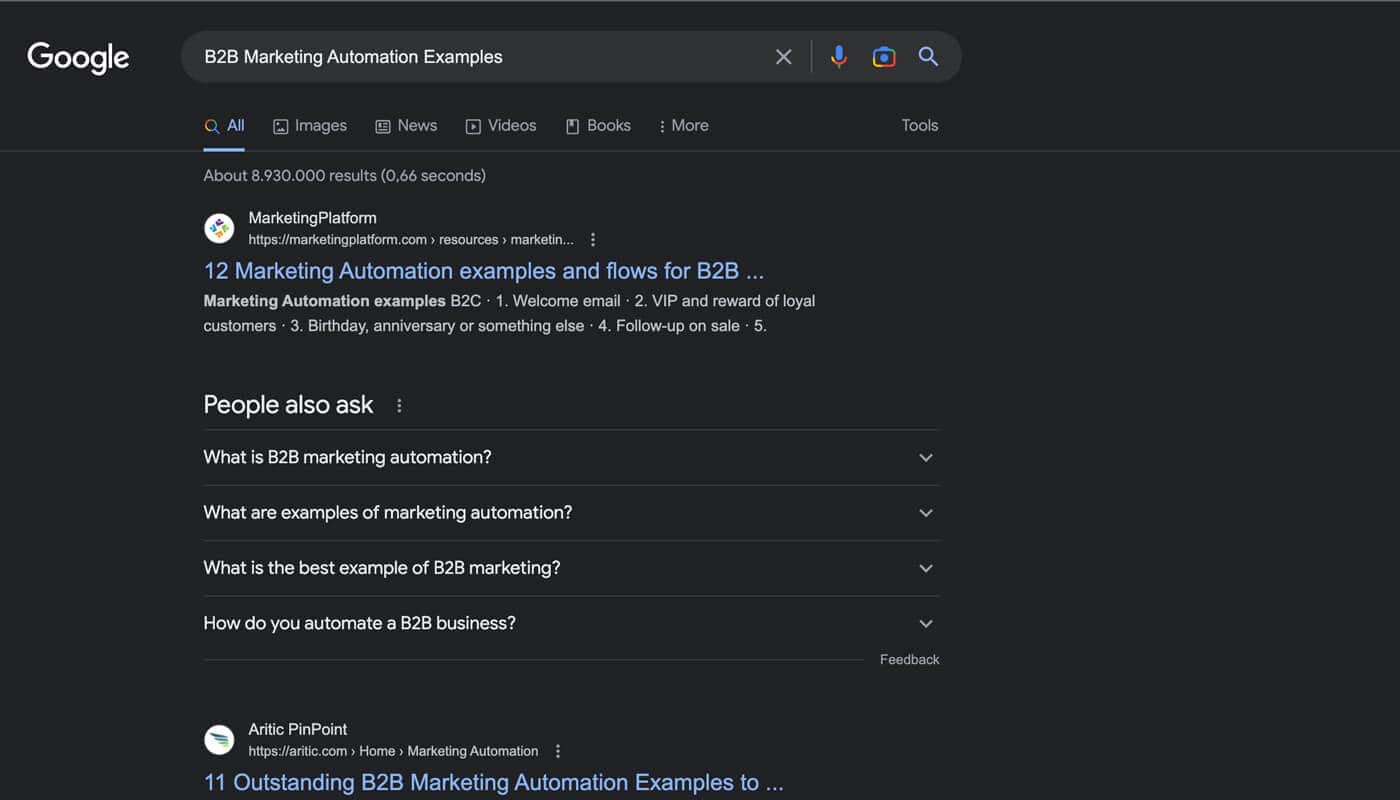
The top results are simple listicles providing a list of examples. That’s the format I need to use.
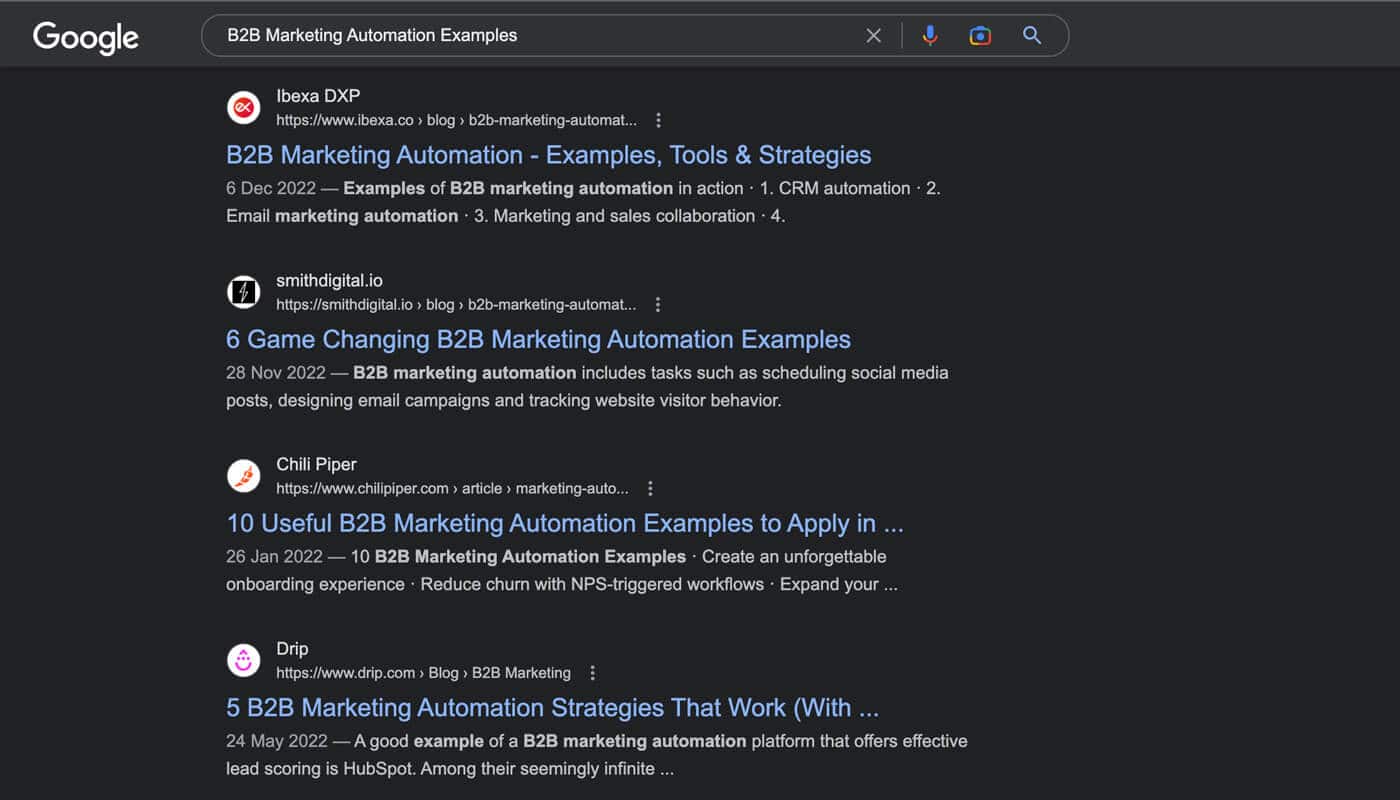
Apart from one blog post which, apart from giving examples, also discusses some tactics and platforms used for marketing automation.
So, up to this point, it is pretty clear that the content type should be a blog post, and its format should be a listicle.
But what’s the angle?
The angle can come from understanding the user’s expectations: what kind of information are they expecting to find when they search for this topic?
For example, here are the titles of the top 7 ranking blog posts:
- 12 Marketing Automation examples and flows for B2B and B2C
- 11 Outstanding B2B Marketing Automation Examples to Consider
- B2B Marketing Automation – Examples, Tools & Strategies
- 6 Game Changing B2B Marketing Automation Examples
- 10 Useful B2B Marketing Automation Examples to Apply in 2022
- 5 B2B Marketing Automation Strategies That Work (With Examples)
- 7 Ways B2B Marketing Automation Could Change Your Business
Most of them include some sort of promise (“Game Changing”, “Outstanding”, “Useful”, “That Work”, and “That Could Change Your Business”).
So if you want to stand out from the competition, your angle should be something like “10 Powerful B2B Marketing Automation Examples”. Or something similar.
You could also turn it around a bit and look through the lens of your solution and its Unique Selling Proposition (USP).
For example, for a B2B marketing automation platform that specializes in automation for small businesses, the angle could be something like “10 B2B Marketing Automation Examples for Small Businesses”. Then, that content piece could showcase real examples of how it helps small companies achieve their goals with marketing automation.
Either way, the point is to have an angle that stands out from what’s already ranking in the SERPs and provides something new or unique. While not drifting too far from the main topic.
Feel free to check out this Google Doc which provides various examples of content types, formats, and angles for inspiration.
4. Highlight the goal of the content project.
What are you hoping to achieve with this particular content project?
The goal of your content should be clear before you start writing the brief.
Here are some common goals a B2B content project might have:
- Generate leads
- Establish thought leadership
- Increase brand awareness
- Increase website traffic
- Increase newsletter subscriber count
Knowing the primary goal of your content will help you focus on the core objectives and create better briefs. It will also help you with the success metrics that can be used to measure the performance of your content.
EXAMPLE
Going back to my example, the goal could be to establish thought leadership and, at the same time, generate free trial sign-ups.
5. Describe the target audience.
Who are you trying to reach with this particular content project?
Creating a profile of your target audience or a buyer persona will help you create a content brief that is well-tailored to their needs.
To do this, you should list the demographics as well as the psychographics of your target audience. You can use Hubspot’s Buyer Persona Generator to get started quickly.
EXAMPLE
For my example, the target audience would include small business owners and/or Marketing Managers that are looking for ways to get started with B2B marketing automation. They are likely to be between 25 and 44 years of age and they’re probably looking for simple, cost-effective marketing automation examples.
Of course, this is a very simplified profile, but it gives us a starting point for the brief.
6. Identify and analyze the competition.
Analyzing the competition is one of the most important steps when creating a content brief.
To identify the right competitors simply do a Google search for your target topic and analyze the top 10 results. Then pick out those competitors that provide the best quality content.
You should then thoroughly analyze the competitors’ content and determine what you can do to make yours better.
Take note of things like:
- Content length
- Content structure
- Headlines
- The overall quality of the written content
- Tone of voice
- Amount of real value the content provides
- Unique examples
- Visual elements
- Downloadable resources
- Etc.
TIP
When choosing the competitors to analyze, pay particularly close attention to the ones that have a lower Domain Authority (DA) rating than the average of those in the SERP.
You can use any of the free Chrome Extensions that show this rating such as MozBar or Keywords Everywhere, to see it right in the SERPs.
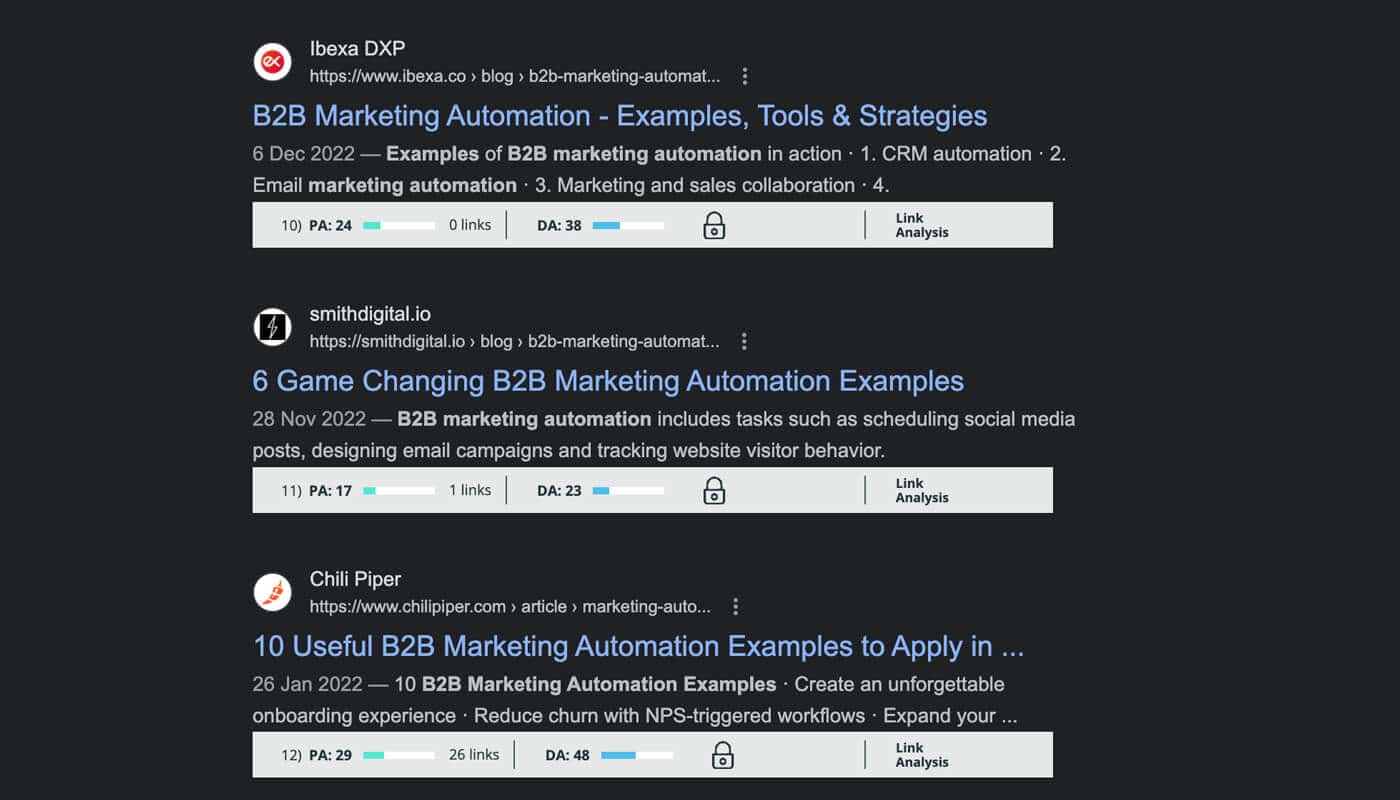
If less authoritative sites are ranking in the top 10 – they are punching above their weight class. Those sites must do something well that the search engine wants to reward. Spend some more time analyzing their content and trying to determine what that is.
In the end, take note of 3 – 6 competitors that offer the best content to use as a source of inspiration and a reference point for your own content.
7. Choose the best calls to action (CTAs).
It is often said that the ultimate purpose of content marketing is to turn readers into customers.
To do this, you will need to include effective calls to action (CTAs) in your content.
This can range from including a link to download an eBook at the end of a blog post, to promoting a product in the body of an article or asking readers to subscribe to your newsletter.
Your CTA should be tailored to match the goal of the entire project while being hyper-relevant to the content you are presenting.
EXAMPLE
For my example, I could choose to include a link at the end of the article, asking people to sign up for a free trial. Or, even better, multiple links leading to a free trial signup page after every example that features the company’s solution.
Similar to how Zapier does it in their articles.
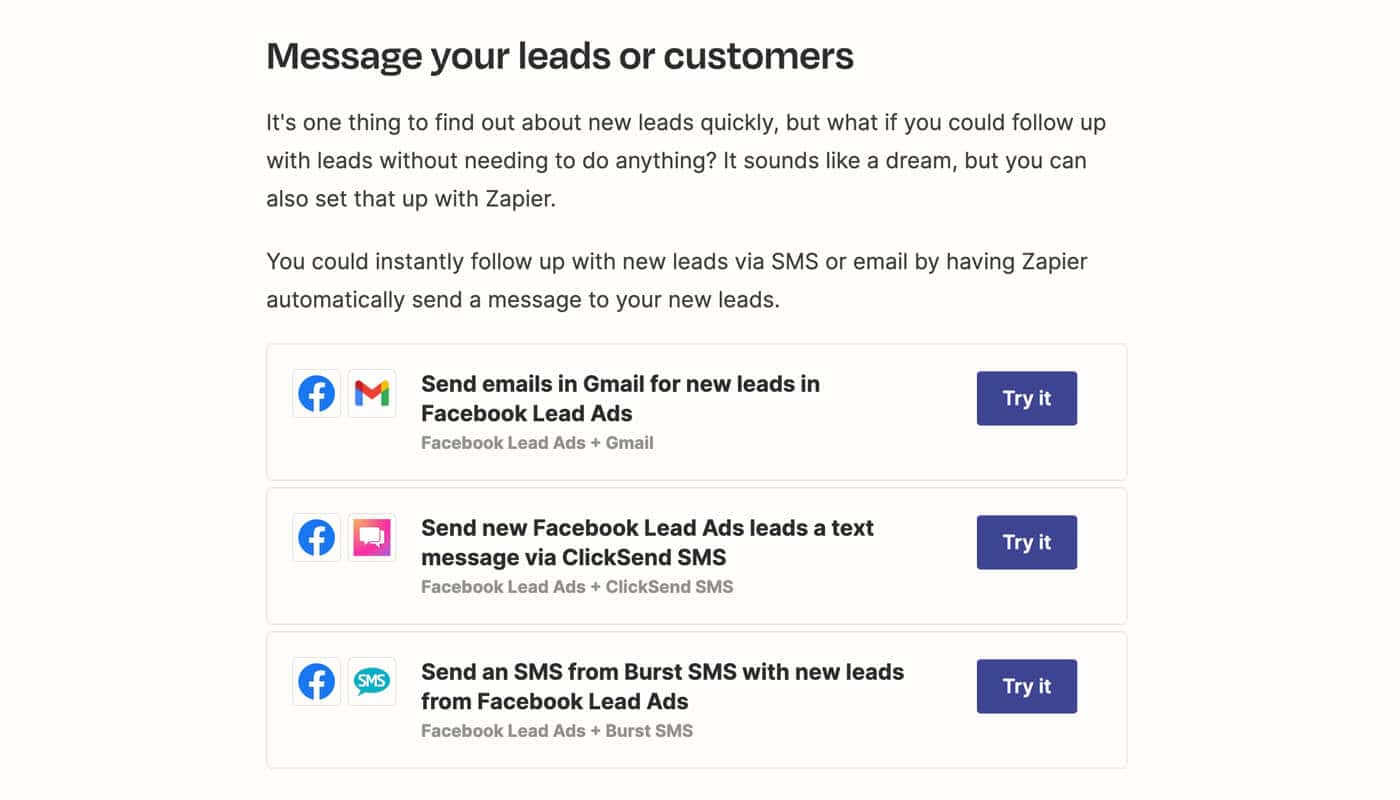
8. Give a preferred word count estimate.
In general, content should always be long enough to adequately cover the topic, but not so lengthy that it becomes overwhelming for the reader.
When it comes to B2B content, due diligence and thorough research will often result in longer pieces.
That said, make sure to give a preferred word count estimate in your content brief, as this will give your writer a good idea of what length to aim for.
Check the average content length of the competitors you identified, add 10-20%, and use that as your preferred word count.
TIP
To quickly check the average word count of a competitor’s content while staying on the SERP page, you can use a free Chrome extension like Keyword Surfer.
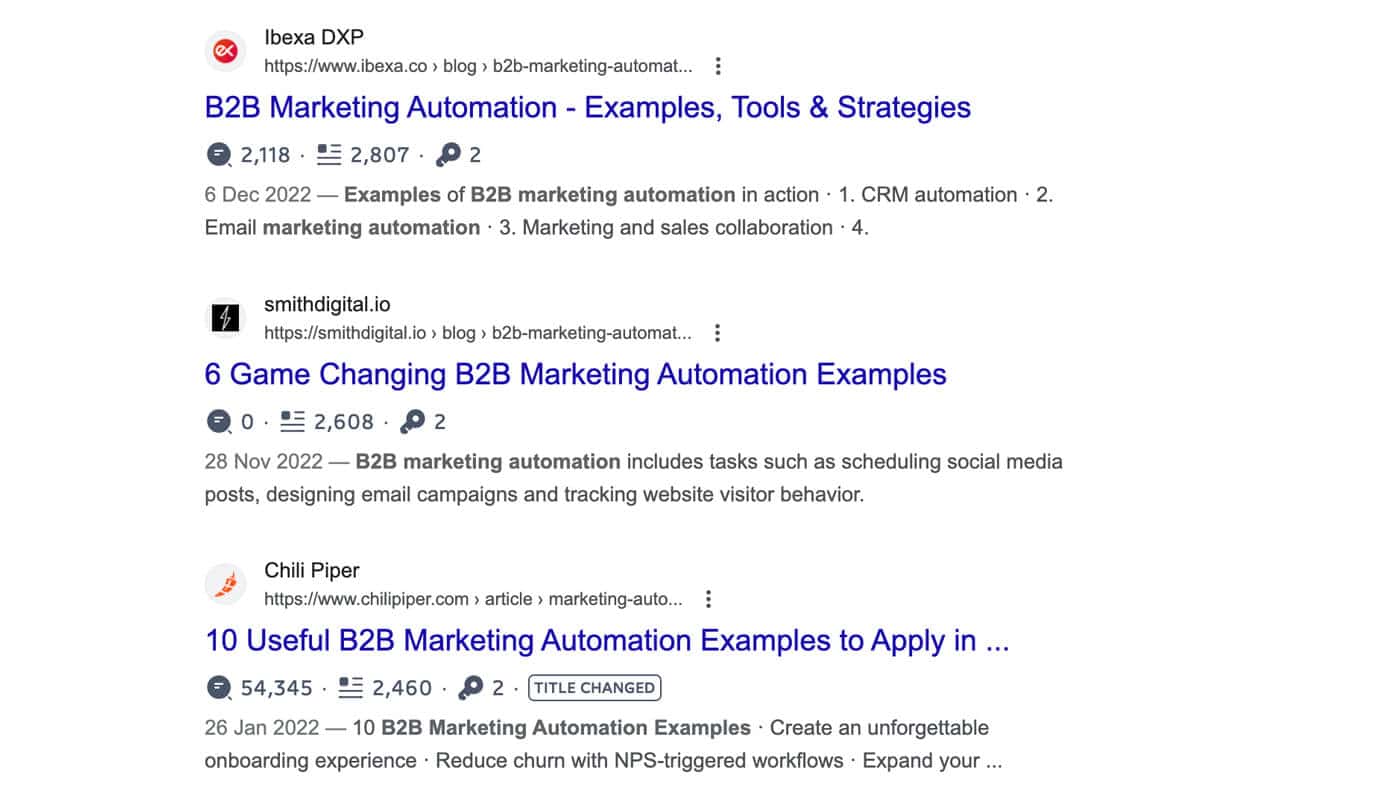
9. Create a content outline.
Probably the most important step in the content brief creation process is to create a detailed outline of your content.
It will act as a roadmap for your writer, helping them stay on track and organized while creating the content.
The outline should include the following:
- Headings and subheadings, structured in a logical order
- Key bullet points or a summary for each section
- Other relevant notes, such as quotes or examples, CTAs that you would like included, etc.
To learn more about how to create an effective content outline, check out our article on the topic.
EXAMPLE
Here is a rough outline for my example blog post:
- [h1] 10 B2B Marketing Automation Examples for Small Businesses
- [h2] 1. Automated Email Campaigns
- [h2] 2. Lead Scoring
- [h2] 3. Automated Lead Qualification
- [h2] 4. Social Media Marketing Automation
- [h2] 5. Automated Landing Pages
- [h2] 6. Webinar Marketing Automation
- [h2] 7. Automated Lead Nurturing
- [h2] 8. Automated Customer Onboarding
- [h2] 9. Automated Customer Retention
- [h2] 10. Automated Customer Service
- [h2] Conclusion
The whole outline is listed in the full example below.
10. List internal and external link ideas.
You should also list any external links that you would like included in the content.
These can help to explain certain points further, provide additional resources, or just serve as general external sources of more detailed information.
If you already have some in mind, make sure to list them in the content brief.
In addition, if there are any internal pages that you would like to link out to (for example, a product page or a related article from your blog), add those to the brief as well.
Furthermore, internal links that should link to this new piece of content after publishing should also be stated in the brief. It will be much easier and quicker to add them once the content is live.
11. Specify any visuals that could be used.
Visuals are essential for any piece of content and can help to break up the text, draw attention to certain points, or explain concepts in a more efficient way.
Include any visuals that you’d like the writer to use, or specify the type of visuals you’d like them to look for.
If no particular visuals come to mind, leave that part up to the writer and trust their creativity.
12. Provide on-page SEO details.
If the content is intended to be published on your website, you should also provide some on-page SEO details for the writer, for example:
- SEO page title
- SEO meta description
- Preferred URL
- Primary keywords
- Secondary keywords
Additionally, if you use any of the content optimization tools such as Surfer, Marketmuse, Clearscope, Page Optimizer Pro, etc. you can include a link to the corresponding report as well. Then, ask your writer or the SEO specialist on your team to use the link to quickly access the tool and optimize the content accordingly.
There is much more than this when it comes to creating SEO-optimized content briefs, so be sure to check out the guide on this topic right here.
13. Include brand, writing, and tone of voice guidelines.
It is also essential to include any brand guidelines, writing style guides, and general tone of voice rules in the brief.
These are key to ensuring that the writer creates content that is cohesive and consistent with your brand’s style.
If you don’t have any of those written down yet, start by creating a basic style sheet with the key aspects of your brand’s tone of voice, and some general key writing rules.
Every company should have one of these documents, and every writer should be familiar with it before starting any content project. It is a very important part of creating consistent content.
14. Set deadlines.
Finally, make sure to include the deadlines for some of the key milestones.
For example, the deadlines I typically set are:
- The date of submission (when the first draft should be submitted)
- The date of publication (for when the final version should be published)
Depending on the project, you might set additional milestones or deadlines. It all depends on your content production processes, needs, and desired delivery timelines.
15. Share the content brief with stakeholders.
Once the content brief is ready, don’t forget to share it with all of the stakeholders who need to be involved. This could include other members of the content team, marketers, SEO specialists, etc.
This helps to ensure that everyone is on the same page and that all of the necessary details are included in the brief.
After that, you, together with other stakeholders could continue with the development of the content distribution and promotion plan, but that’s outside the scope of this article.
Example of a B2B Content Brief
Throughout the article, you have already seen examples of some parts of my imaginary content brief for the topic of “B2B marketing automation examples”.
Here is what it would look like all put together:
You can get a copy of this brief in PDF, Word, or Google Docs if you wish to use it as an example.
Streamline B2B Content Projects Using Content Briefs
Creating the perfect B2B content brief takes practice, but once you get the hang of it and start using them for all of your content projects, you will save a lot of time and effort.
With the brief in place, everybody on your team is aware of what needs to be done, how, and when, which makes it easier to track your projects, collaborate on them, and ensure that the final content pieces are created according to the standards.
Use the guide above as well as the content brief template to start streamlining your content creation processes today.
